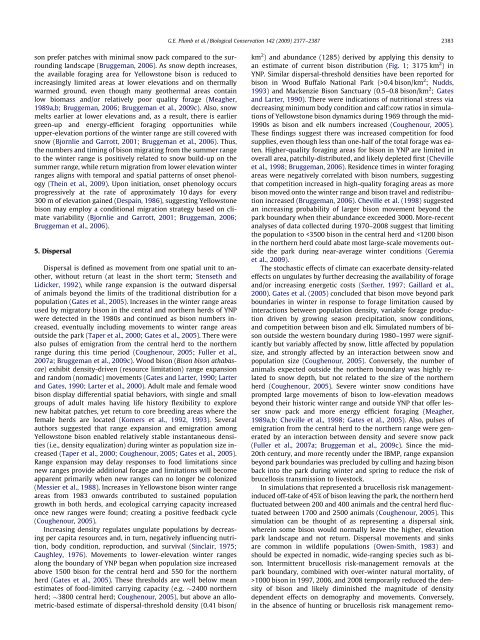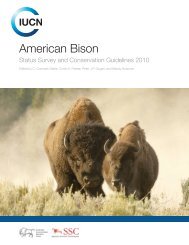Carrying capacity, migration, and dispersal in ... - ResearchGate
Carrying capacity, migration, and dispersal in ... - ResearchGate
Carrying capacity, migration, and dispersal in ... - ResearchGate
Create successful ePaper yourself
Turn your PDF publications into a flip-book with our unique Google optimized e-Paper software.
son prefer patches with m<strong>in</strong>imal snow pack compared to the surround<strong>in</strong>g<br />
l<strong>and</strong>scape (Bruggeman, 2006). As snow depth <strong>in</strong>creases,<br />
the available forag<strong>in</strong>g area for Yellowstone bison is reduced to<br />
<strong>in</strong>creas<strong>in</strong>gly limited areas at lower elevations <strong>and</strong> on thermally<br />
warmed ground, even though many geothermal areas conta<strong>in</strong><br />
low biomass <strong>and</strong>/or relatively poor quality forage (Meagher,<br />
1989a,b; Bruggeman, 2006; Bruggeman et al., 2009c). Also, snow<br />
melts earlier at lower elevations <strong>and</strong>, as a result, there is earlier<br />
green-up <strong>and</strong> energy-efficient forag<strong>in</strong>g opportunities while<br />
upper-elevation portions of the w<strong>in</strong>ter range are still covered with<br />
snow (Bjornlie <strong>and</strong> Garrott, 2001; Bruggeman et al., 2006). Thus,<br />
the numbers <strong>and</strong> tim<strong>in</strong>g of bison migrat<strong>in</strong>g from the summer range<br />
to the w<strong>in</strong>ter range is positively related to snow build-up on the<br />
summer range, while return <strong>migration</strong> from lower elevation w<strong>in</strong>ter<br />
ranges aligns with temporal <strong>and</strong> spatial patterns of onset phenology<br />
(The<strong>in</strong> et al., 2009). Upon <strong>in</strong>itiation, onset phenology occurs<br />
progressively at the rate of approximately 10 days for every<br />
300 m of elevation ga<strong>in</strong>ed (Despa<strong>in</strong>, 1986), suggest<strong>in</strong>g Yellowstone<br />
bison may employ a conditional <strong>migration</strong> strategy based on climate<br />
variability (Bjornlie <strong>and</strong> Garrott, 2001; Bruggeman, 2006;<br />
Bruggeman et al., 2006).<br />
5. Dispersal<br />
Dispersal is def<strong>in</strong>ed as movement from one spatial unit to another,<br />
without return (at least <strong>in</strong> the short term; Stenseth <strong>and</strong><br />
Lidicker, 1992), while range expansion is the outward <strong>dispersal</strong><br />
of animals beyond the limits of the traditional distribution for a<br />
population (Gates et al., 2005). Increases <strong>in</strong> the w<strong>in</strong>ter range areas<br />
used by migratory bison <strong>in</strong> the central <strong>and</strong> northern herds of YNP<br />
were detected <strong>in</strong> the 1980s <strong>and</strong> cont<strong>in</strong>ued as bison numbers <strong>in</strong>creased,<br />
eventually <strong>in</strong>clud<strong>in</strong>g movements to w<strong>in</strong>ter range areas<br />
outside the park (Taper et al., 2000; Gates et al., 2005). There were<br />
also pulses of e<strong>migration</strong> from the central herd to the northern<br />
range dur<strong>in</strong>g this time period (Coughenour, 2005; Fuller et al.,<br />
2007a; Bruggeman et al., 2009c). Wood bison (Bison bison athabascae)<br />
exhibit density-driven (resource limitation) range expansion<br />
<strong>and</strong> r<strong>and</strong>om (nomadic) movements (Gates <strong>and</strong> Larter, 1990; Larter<br />
<strong>and</strong> Gates, 1990; Larter et al., 2000). Adult male <strong>and</strong> female wood<br />
bison display differential spatial behaviors, with s<strong>in</strong>gle <strong>and</strong> small<br />
groups of adult males hav<strong>in</strong>g life history flexibility to explore<br />
new habitat patches, yet return to core breed<strong>in</strong>g areas where the<br />
female herds are located (Komers et al., 1992, 1993). Several<br />
authors suggested that range expansion <strong>and</strong> e<strong>migration</strong> among<br />
Yellowstone bison enabled relatively stable <strong>in</strong>stantaneous densities<br />
(i.e., density equalization) dur<strong>in</strong>g w<strong>in</strong>ter as population size <strong>in</strong>creased<br />
(Taper et al., 2000; Coughenour, 2005; Gates et al., 2005).<br />
Range expansion may delay responses to food limitations s<strong>in</strong>ce<br />
new ranges provide additional forage <strong>and</strong> limitations will become<br />
apparent primarily when new ranges can no longer be colonized<br />
(Messier et al., 1988). Increases <strong>in</strong> Yellowstone bison w<strong>in</strong>ter range<br />
areas from 1983 onwards contributed to susta<strong>in</strong>ed population<br />
growth <strong>in</strong> both herds, <strong>and</strong> ecological carry<strong>in</strong>g <strong>capacity</strong> <strong>in</strong>creased<br />
once new ranges were found; creat<strong>in</strong>g a positive feedback cycle<br />
(Coughenour, 2005).<br />
Increas<strong>in</strong>g density regulates ungulate populations by decreas<strong>in</strong>g<br />
per capita resources <strong>and</strong>, <strong>in</strong> turn, negatively <strong>in</strong>fluenc<strong>in</strong>g nutrition,<br />
body condition, reproduction, <strong>and</strong> survival (S<strong>in</strong>clair, 1975;<br />
Caughley, 1976). Movements to lower-elevation w<strong>in</strong>ter ranges<br />
along the boundary of YNP began when population size <strong>in</strong>creased<br />
above 1500 bison for the central herd <strong>and</strong> 550 for the northern<br />
herd (Gates et al., 2005). These thresholds are well below mean<br />
estimates of food-limited carry<strong>in</strong>g <strong>capacity</strong> (e.g. 2400 northern<br />
herd; 3800 central herd; Coughenour, 2005), but above an allometric-based<br />
estimate of <strong>dispersal</strong>-threshold density (0.41 bison/<br />
G.E. Plumb et al. / Biological Conservation 142 (2009) 2377–2387 2383<br />
km 2 ) <strong>and</strong> abundance (1285) derived by apply<strong>in</strong>g this density to<br />
an estimate of current bison distribution (Fig. 1; 3175 km 2 ) <strong>in</strong><br />
YNP. Similar <strong>dispersal</strong>-threshold densities have been reported for<br />
bison <strong>in</strong> Wood Buffalo National Park (>0.4 bison/km 2 ; Nudds,<br />
1993) <strong>and</strong> Mackenzie Bison Sanctuary (0.5–0.8 bison/km 2 ; Gates<br />
<strong>and</strong> Larter, 1990). There were <strong>in</strong>dications of nutritional stress via<br />
decreas<strong>in</strong>g m<strong>in</strong>imum body condition <strong>and</strong> calf:cow ratios <strong>in</strong> simulations<br />
of Yellowstone bison dynamics dur<strong>in</strong>g 1969 through the mid-<br />
1990s as bison <strong>and</strong> elk numbers <strong>in</strong>creased (Coughenour, 2005).<br />
These f<strong>in</strong>d<strong>in</strong>gs suggest there was <strong>in</strong>creased competition for food<br />
supplies, even though less than one-half of the total forage was eaten.<br />
Higher-quality forag<strong>in</strong>g areas for bison <strong>in</strong> YNP are limited <strong>in</strong><br />
overall area, patchily-distributed, <strong>and</strong> likely depleted first (Cheville<br />
et al., 1998; Bruggeman, 2006). Residence times <strong>in</strong> w<strong>in</strong>ter forag<strong>in</strong>g<br />
areas were negatively correlated with bison numbers, suggest<strong>in</strong>g<br />
that competition <strong>in</strong>creased <strong>in</strong> high-quality forag<strong>in</strong>g areas as more<br />
bison moved onto the w<strong>in</strong>ter range <strong>and</strong> bison travel <strong>and</strong> redistribution<br />
<strong>in</strong>creased (Bruggeman, 2006). Cheville et al. (1998) suggested<br />
an <strong>in</strong>creas<strong>in</strong>g probability of larger bison movement beyond the<br />
park boundary when their abundance exceeded 3000. More-recent<br />
analyses of data collected dur<strong>in</strong>g 1970–2008 suggest that limit<strong>in</strong>g<br />
the population to










